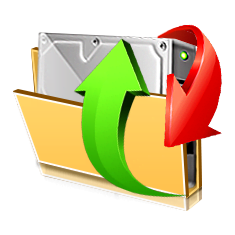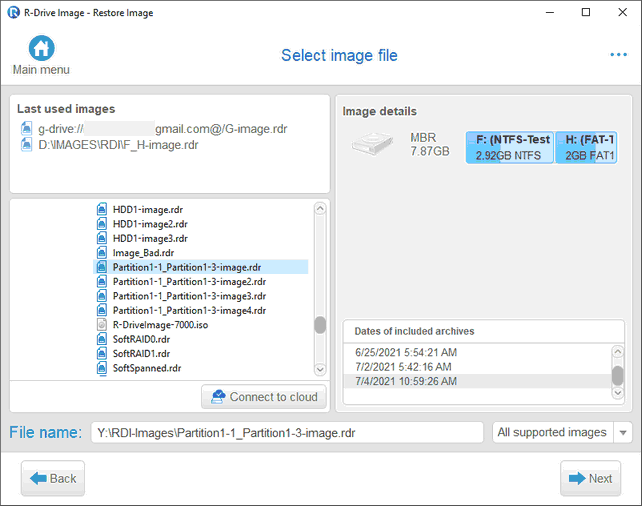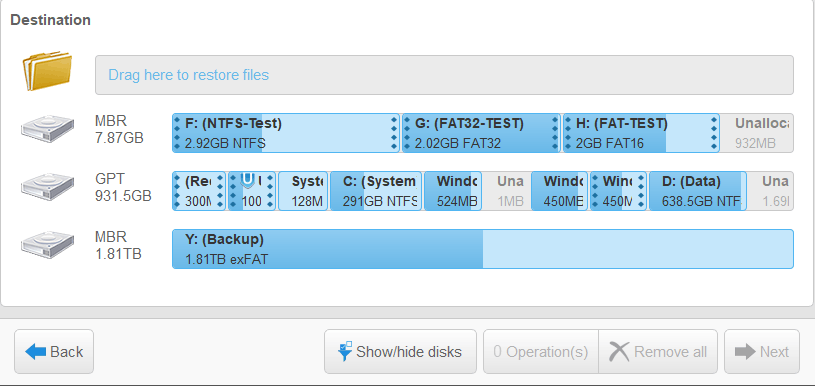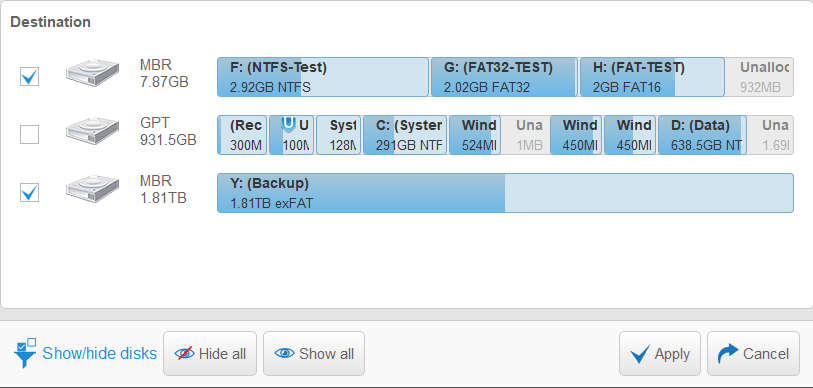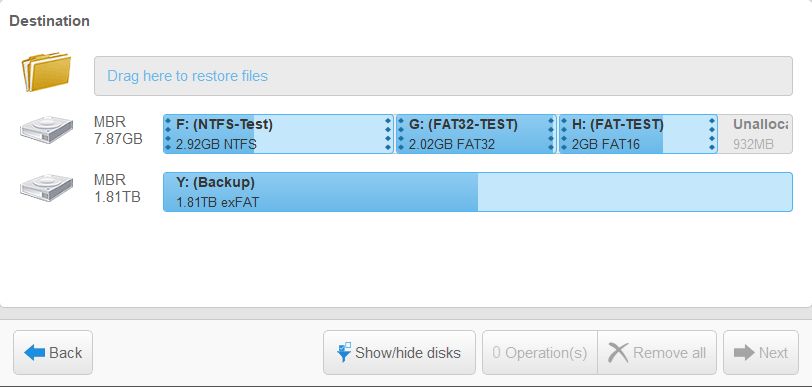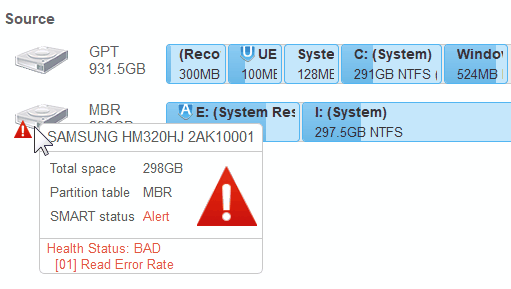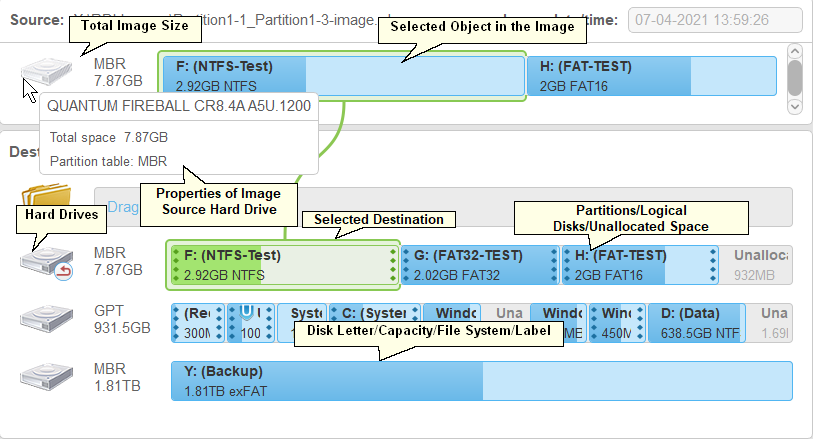- Contents
- Index
- . -
- A -
- B -
Backup Options
|
|
Ignore disk read errors (bad sectors)
|
|
|
|
|
|
|
|
|
|
Windows Volume Snapshot Service
|
BitLocker
BitLocker System Drive Encryption
- C -
configure startup media troubleshooting options
Contact information and technical support
Context menu
Create a script from an existing task
Create a script from R-Drive Image
Create Partition Parameters
Creating consistent point-in-time bakups
Custom rotation schemes options
Maximum size of all image files
- D -
Dialog boxes
- E -
- F -
File systems
Format partition options
- G -
Grandfather-Father-Son schemes options
Maximum size of all image files
- H -
HDD Copy Method
Copy all partitions onto original places
Expand/Shrink partition to whole disk
- I -
Image file format
Image Options
Volume size for multi-volume image
Image Options options
Compare file contents even for matching files
Remove files in the destination that have no matching files in the source
Shutdown computer when completed
Imaging Options
- K -
- L -
Linux Logical Volume Manager Volumes
List of Hardware Devices Supported in the Startup Mode
Load Computer into Startup Mode
- M -
Mail Notification Options
Media Options
Include R-Drive Image bootable version
Message
Messages
Choose drive(s) to umount them
Error: Another partitioner is active
Image selected is larger than destination
Insert a blank CD-R/RW disk...
Insert the next blank CD-R/RW disk...
Insert the next blank floppy disk...
ISO-image created successfully
|
Startup disks created successfully
Virtual disk(s) mounted successfully
You have selected several partitions...
Mount
Drive letter for the selected partition
Mount an image as a virtual logical disk
- N -
Notifications options
- O -
OEM Client Media Options
Automatically reboot on successful restore
Client will search image on all disks
Perform restoration without confirmation
- P -
Panels
|
Choose destination of new image
Choose image to check integrity
Choose image to mount drive(s) from
Mail Notification/Aux Applications
Removable Media Device Selection
Removable Storage Device Selection
Select disk(s) to create image
Partition layouts
Partition Manager
- R -
RAIDs, and Various Disk and Volume Managers
Restore Options
Drive letter for the selected partition
File system for the selected partitions
- S -
Scheduled actions, command line operations, and scripting
Scheduler and unattended actions
Script commands and parameters
Scripting and command line operations
Simple rotation scheme options
Maximum size of all image files
Create an image using the startup disks
Restore data to a system or another locked disk
Support for Various non-MBR/GPT Partition Layouts
Supported CD and DVD recorders
- T -
Task execution schedule options
Run missed task as soon as possible
Wake the computer to run this task
Tower-of-Hanoi schemes options
- U -
- V -
- W -
Windiows explorer shortcut menu
Windows Software Spanned Volumes
Windows Storage Spaces
Wiping algorithms
Restore Data from an Image
Note: You may read about Support for Various Disk Partition Schemes and File Systems to learn more about possible options for your specific case.
We recommend you stop all other programs before you start restoring data on a partition.
Note: Go to the Restoring Data to a System or Other Locked Disk topic if you want to learn how to restore data to system disk s.
You may restore data from images for entire disk objects or restore only selected files .
Restoring partitions and entire disks
R-Drive Image can smoothly copy/restore drives/images onto larger drives or drives of the same size. Moreover, it can shrink/extend partitions with some file systems if need be.
Whether R-Drive Image can copy/restore data onto a smaller drive depends on the last cluster in the file system of the source drive/image. It cannot do this if the data blocks are physically located outside the boundaries of the smaller drive, even when the total size of the file system is smaller than the drive size. Try to defragment the source drive then.
To restore data from an image to a disk/partition:
| 1 | Click Restore Image on the Action Selection panel. |
R-Drive Image will start analyzing the computer disk configuration, the Progress... message showing the progress. Then R-Drive Image will show you the Choose image file panel with the disks/folder structure.
| 2 | Select the file with the image on the Choose image file panel and click the Next button |
In addition to the rdr native file format, R-Drive Image support several virtual disk and disk image formats .
Click the controls to learn their functions or go to the respective help pages
When you click the file, you may view its content in the right panel.
 More information...
More information...
|
||||||||
You may also restore data directly from Windows explorer by right-clicking the required image file with the .rdr extension and selecting Restore Image from the shortcut menu.
If you select an image with incremental or differential data backup, select the date and time of image creation and click the Next button.
If the image file is password-protected, the Password prompt... message will appear. Enter the password and click the OK button.
| 3 | Select the object in the image file on the Image Object Selection panel, select a destination, and click the Next button |
Use the Refresh button if your computer disk configuration has been changed (when you connect a USB disk, for example).
R-Drive Image may show only those disks that you wand to see.
|
To hide/show disks:
|
You may select all objects on a hard drive by clicking the hard drive icon .. It will show the marked hard drive .
You may select only one object at a time, and you need to specify the destination to proceed further.
![]() S.M.A.R.T. warning for a hard drive
S.M.A.R.T. warning for a hard drive
|
If a hard drive has S.M.A.R.T. warnings, a color mark will appear on its left-top corner. Dragging the cursor over the drive will show a tooltip explaining that warning.
Warnings will also appear in confirming e-mails for scheduled actions . * ===================[S.M.A.R.T.]=================== ! SAMSUNG HM320HJ 2AK10001(298GB #2): Health Status: BAD [01] Read Error Rate ! ===================[S.M.A.R.T.]=================== S.M.A.R.T. (Self-Monitoring, Analysis and Reporting Technology) is a technology widely-used in hard drives and solid-state devices that monitors their reliability conditions to predict possible hardware failures. |
 More information...
More information...
|
If the chosen destination is smaller than the selected image, R-Drive Image will show the Destination disk is too small message and you will need to select another destination. If you select several partitions as the destination, R-Drive Image will show the You have selected several partitions... message. If you click the OK button, all those partitions will be deleted and data will be restored on that free space . Note: Although R-Drive Image shows unallocated space instead of the deleted partitions, the partitions and their data will be actually deleted only when R-Drive Image starts restoring the data from the image. |
|
Selected Object and Destination
|
|
You may change create/copy/modify parameters on the Create partition , Copy partition , or Modify partition panel. Click the Create / Copy Options / Modify button, respectively.
|
|
Partition ing scheme |
The type of partition ing scheme . See Support for Various Disk Partition Schemes and File Systems for the list of supported partition types. |
|
Partition type |
Primary (Active)/ Primary/Logical You may specify the type of the partition to be restored. Do not change this setting unless you have serious reasons to do so. |
|
File system |
You may select the file system for the partition to be restored. |
|
Allocation unit size |
It is the size of a disk block, that is, the minimum allocatable disk space. (only on the Create partition panel.) |
|
Volume label |
Label of this volume. You can change it. |
|
Drive letter |
Select the letter that will be assigned to the partition. You may select "Do not connect" if you do not want to connect this partition to your system. Or "Do not modify" it you do not want to change the drive letter. |
|
Partition size |
Minimum/maximum size of the partition to be restored. |
|
Free space before |
You may specify the size of free space that will be left on the hard drive before the beginning of the partition. |
|
Partition size |
You may specify the size of the partition to be restored. Should be between the minimum and maximum partition size. |
|
Free space after |
You may specify the size of free space that will be left on the hard drive after the end of the partition. |
|
|
You may visually adjust the location and size of the object to be restored. All other restore options will be adjusted accordingly. Also, when you adjust one or several restore options directly, these changes will be shown visually. Green marks available space. See Support for Various Disk Partition Schemes and File Systems for the list of supported file systems. |
You may format a disk if necessary. Click the Format button and select the format parameters on the Format partition panel.
 Format partition options
Format partition options
|
File system |
You may select the file system for the partition to be formatted . |
|
Allocation unit size |
It is the size of a disk block, that is, the minimum allocatable disk space. |
|
Volume label |
Label for this volume. |
You may also delete or wipe selected disk object by clicking the Delete button. Click the Clear HDD or Wipe button if you want to delete all object on the hard drive or wipe its data. Go to the Partition Manager help page for more details..
|
The Restore/Copy Parameters panel will be different with different sets of options:
See Support for Various Disk Partition Schemes and File Systems for details. When you restore data from an image of a system disk, a disk signature collision may occur. In this case, the Disk Signature Collision panel will appear. You may specify the way to resolve this collision on this panel.
|
||||||||||||||||||||
If you try to restore data to a system or other disk locked by the system or other application, the Disk not locked message will appear.
 To continue restoring you may:
To continue restoring you may:
|
• If you restore data to your system disk , select Restart computer (recommended) to continue restoring the data in the R-Drive Image startup mode. Read carefully the Restoring Data to a System Disk topic before you proceed. • If you restore data to a disk locked by other low-level disk software (including Windows internal services) , stop this software and select Retry to lock the disk once again. • You may also try to unlock the disk by selecting Force Windows to unlock the disk (not recommended) . If Windows fails to unlock the disk, the Disk not locked message will appear again. You will need to stop the software locking the disk manually or select Restart computer (recommended) to continue restoring the data in the R-Drive Image startup mode . Note: Use this option cautiously, because it may cause unpredictable results including system crash and data loss. |
| 6 | Verify that the information on the Processing panel is correct and click the Start button |
You may also create a script for this action. Click the Script to Clipboard button and paste the script to any text-processing utility .
| > | R-Drive Image will start restoring the data from the image file to the selected destination. |
When the image is restored, the Image restored successfully message will appear.
If some other program (like a file manager) is accessing the partition on which the data is to be restored, the Cannot lock the disk message will appear. Close this program or make it stop accessing the partition.
If you restore data from an image of an entire hard drive to an entire hard drive, the system may not see the restored partitions until restarted. In this case R-Drive Image will show the Disk image restored successfully. message. Click the Yes button to restart your system.
 Restoring data from CD-R/RW drives or other devices with removable storage
Restoring data from CD-R/RW drives or other devices with removable storage
|
For the image with the file name filename.rdr , R-Drive Image creates the following disk/file structure: |
|
|
Disk |
File name |
|
The first disk |
filename1.rdr |
|
The second disk |
filename2.rdr |
|
The third disk |
filename3.rdr |
|
... |
... |
|
You should start restoring the data from the last disk. Each time R-Drive Image requires a new disk, the Insert disk #... message will appear. Insert the necessary disk and click the OK button. Follow the device instructions on how to change its disks. Note : At the beginning, R-Drive Image may require you to change the first/last disks several times. |
|
 Bad Sectors
Bad Sectors
|
When R-Drive Image encounters a bad sector, the IO Error message will appear. You may either cancel the current action or fill the bad sectors with zeros. IO Error Options
|
Restoring selected files and folders
(See Support for Various Disk Partition Schemes and File Systems for the list of supported file systems)
| 1 | Click Restore Image on the Action Selection panel |
R-Drive Image will start analyzing the computer disk configuration, the Progress... message showing the progress. Then R-Drive Image will show you the Choose image file panel with the disks/folder structure.
| 2 | Select the file with the image on the Choose image file panel and click the Next button |
When you click the file, you may view its content in the right panel.
If you select an image with incremental or differential data backup, select the date and time of image creation and click the Next button
If the image file is password-protected, the Password prompt... message will appear. Enter the password and click the OK button.
| 3 | Select the object in the image file on the Image Object Selection pane where the files and folders reside, and click the Next button |
| 4 | Mark folders and files to restore on the Select Files to Restore panel, specify the output folder, and click the OK button |
You may also specify Options that specifies paths for restored files, control processing of already existing files, and what to do with file attributes.
You may search for individual files , use filters , or the Batch mode if you want to include all files of several patterns. Such patterns may include multiple file names, masks, and paths.
| 5 | Click the Next button to continue file restore on the Image Object Selection panel. |
| 6 | Verify that the information on the Processing panel is correct and click the Start button |
You may also create a script for this action. Click the Script to Clipboard button and paste the script to any text-processing utility.
| > | R-Drive Image will start restoring the files from the image file to the selected destination. |
If the files already exist in the specified folder, The file exists message will appear. Click the necessary button to resume the restore operation.
When the image is restored, the Files restored successfully message will appear.
The Disk Actions chapter explains basic disk actions.
The Startup Version chapter explains how to perform disk actions using the R-Drive Image Startup Version .
The Technical Information chapter gives technical information on Supported CD and DVD Recorders and List of Hardware Devices Supported in the Startup Mode and another useful technical information.
Follow this link to obtain R-Drive Image Contact Information and Technical Support
- R-Studio Technician: activation using a USB stick
- Data Recovery Guide
- Why R-Studio?
- R-Studio for Forensic and Data Recovery Business
- R-STUDIO Review on TopTenReviews
- File Recovery Specifics for SSD devices
- How to recover data from NVMe devices
- Predicting Success of Common Data Recovery Cases
- Recovery of Overwritten Data
- Emergency File Recovery Using R-Studio Emergency
- RAID Recovery Presentation
- R-Studio: Data recovery from a non-functional computer
- File Recovery from a Computer that Won't Boot
- Clone Disks Before File Recovery
- HD Video Recovery from SD cards
- File Recovery from an Unbootable Mac Computer
- The best way to recover files from a Mac system disk
- Data Recovery from an Encrypted Linux Disk after a System Crash
- Data Recovery from Apple Disk Images (.DMG files)
- File Recovery after Re-installing Windows
- R-Studio: Data Recovery over Network
- How To Use R-Studio Corporate Package
- Data Recovery from a Re-Formatted NTFS Disk
- Data Recovery from an ReFS disk
- Data Recovery from a Re-Formatted exFAT/FAT Disk
- Data Recovery from an Erased HFS Disk
- Data Recovery from an Erased APFS Disk
- Data Recovery from a Re-Formatted Ext2/3/4FS Disk
- Data Recovery from an XFS Disk
- Data Recovery from a Simple NAS
- How to connect virtual RAID and LVM/LDM volumes to the operating system
- Specifics of File Recovery After a Quick Format
- Data Recovery After Partition Manager Crash
- File Recovery vs. File Repair
- Data Recovery from Virtual Machines
- How to Connect Disks to a Computer
- Emergency Data Recovery over Network
- Data Recovery over the Internet
- Creating a Custom Known File Type for R-Studio
- Finding RAID parameters
- Recovering Partitions on a Damaged Disk
- NAT and Firewall Traversal for Remote Data Recovery
- Data Recovery from an External Disk with a Damaged File System
- File Recovery Basics
- Default Parameters of Software Stripe Sets (RAID 0) in Mac OS X
- Data Recovery from Virtual Hard Disk (VHD/VHDX) Files
- Data Recovery from Various File Container Formats and Encrypted Disks
- Automatic RAID Parameter Detection
- IntelligentScan Data Recovery Technology
- Multi-pass imaging in R-Studio
- Runtime Imaging in R-Studio
- Linear Imaging vs Runtime Imaging vs Multi-Pass Imaging
- USB Stabilizer Tech for unstable USB devices
- Joint work of R-Studio and PC-3000 UDMA hardware
- Joint work of R-Studio and HDDSuperClone
- R-Studio T80+ - A Professional Data Recovery and Forensic Solution for Small Business and Individuals Just for 1 USD/day
- Backup Articles
- R-Drive Image Standalone and Corporate license transferring
- Fixing Windows update error 0x80070643 with R-Drive Image
- Backup with Confidence
- R-Drive Image as a free powerful partition manager
- Computer Recovery and System Restore
- Disk Cloning and Mass System Deployment
- Accessing Individual Files or Folders on a Backed Up Disk Image
- R-Drive Image startup / bootable version
- File Backup for Personal Computers and Laptops of Home and Self-Employed Users
- Creating a Data Consistent, Space Efficient Data Backup Plan for a Small Business Server
- How to Move the Already Installed Windows from an Old HDD to a New SSD Device and Create a Hybrid Data Storage System
- How to Move an Installed Windows to a Larger Disk
- How to Move a BitLocker-Encrypted System Disk to a New Storage Device
- How to backup and restore disks on Linux and Mac computers using R-Drive Image
- Undelete Articles
- Get Deleted Files Back
- Free Recovery from SD and Memory cards
- R-Undelete: Video Recovery
- Recovery from an External Device with a Damaged File System
- File recovery from a non-functional computer
- Free File Recovery from an Android Phone Memory Card
- Free Photo and Video File Recovery Tutorial
- Easy file recovery in three steps

